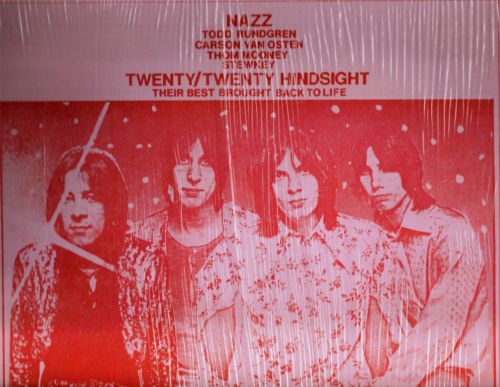

NAZZ:Twenty/Twenty Hindsight(boot US)their best brought back to life…great sound on this rare boot!
Inspired by a variety of British Invasion groups, from the omnipresent Beatles to the cult favorites the Move, Todd Rundgren and his Woody's Truck Stop colleague Carson Van Osten formed the Nazz in 1967. Taking their name from an obscure Yardbirds song, the Nazz were arguably the first Anglophiles in rock history. There had been many groups that drew inspiration from the Beatles and the Stones, but none had been so self-consciously reverent as the Nazz. One of their first singles, "Open My Eyes," twisted the riff from the Who's "I Can't Explain," and much of their music felt like homages to Brit-rock from the Kinks to Cream, thereby setting a precedent that was followed by scores of North American guitar-pop bands from the Raspberries to Sloan.
Playing lead guitar and bass, respectively, Rundgren and Van Osten were joined by drummer Thom Mooney (formerly of the Munchkins) and lead vocalist/keyboardist Stewkey (b. Robert Antoni). The Nazz had their first concert in July 1967, landing an opening slot at a Doors concert. By September, the group received some financial support from the local record store Bartoff and Warfield, who also put them in touch with John Kurland, a record promoter who was looking for a guitar-pop band. Kurland took a shine to the Nazz and signed on as their manager. Throughout the fall, they practiced in their new homebase of Great Neck, New York. Kurland and his associate, Michael Friedman, prevented the band from gigging regularly, believing that a lack of performances would increase demand for the group. The managers also were convinced that the Nazz could be marketed as a sharp, stylish boy-band for the teenybopper audience, and helped the quartet refashion themselves in that mode.
With a wardrobe of clothes and an album's worth of material ready, Kurland and Friedman had the Nazz sign with SGC Records — an off-shoot of Atlantic Records and Columbia-Screen Gems — in the summer of 1968. Their debut album, Nazz, appeared in October, supported by the single "Hello It's Me." Although the song would later become a major hit for Rundgren as a solo artist, the dirgey original version barely scraped the national charts, largely due to mismanagement. The managers wanted the Nazz to only play large halls, which was virtually impossible for an unknown, unproven band with a newly released debut album. As a result, most of the group's publicity was limited to glamour shots and puff pieces in teen mags. Ironically, many of the articles emphasized the band's "electrifying" live performances.
"Hello It's Me" managed to reach #71 on the charts, and the record — particularly the Nazz's self-production of "Open My Eyes" and "Hello It's Me" — attracted some good notices. Taking these as a cue, the group headed to England to cut their second album, but they became embroiled in work visa problems. Undaunted, they returned to America and began work on an ambitious self-produced double-album named Fungo Bat. By the time it was released in April 1969, it was trimmed to a single album, Nazz Nazz. Although the project's scale was diminished, the music remained dizzyingly diverse, as the record ran the gamut from psychedelic rockers to pop ballads. One problem emerged, however. In the process of editing, much of Rundgren's newer, Laura Nyro-influenced material — which he had sung himself — was left on the shelves. Neither the management Nor his bandmates gave Rundgren much encouragement to sing, nor was his new introspective direction warmly received by his colleagues. Faced with a no-win situation, Rundgren left the group not long after their summer 1969 tour; by that time, Van Osten had already departed the band.
Stewkey took control of the Nazz, erased Rundgren's vocals from the album sitting in the vaults, and replaced them with his own. The result was released as Nazz 3 in 1970, but it stiffed. Mooney departed the group, later to play with such bands as the Curtis Brothers, Tattoo and Paris. Stewkey joined Fuse, an anglophile power-pop group featuring future Cheap Trick guitarist Rick Nielsen. Mooney also played with Fuse, but left before Cheap Trick bassist Tom Petersson joined and the group became Sick Man of Europe.
vinyl rip
mid 80s duel deck
mid 80s technics amp
low declick
low denoise
SIDE A
FORGET ALL ABOUT IT
NOT WRONG LONG
MAGIC ME
SHES GOIN DOWN
HANG ON PAUL
KIDDIE BOY
WILDWOOD BLUES
SIDE B
LOOSEN UP
OPEN MY MIND
RAINRIDER
ONLY ONE WINNER
HELLO ITS ME
MERIDIAN LEEWARD
UNDER THE ICE